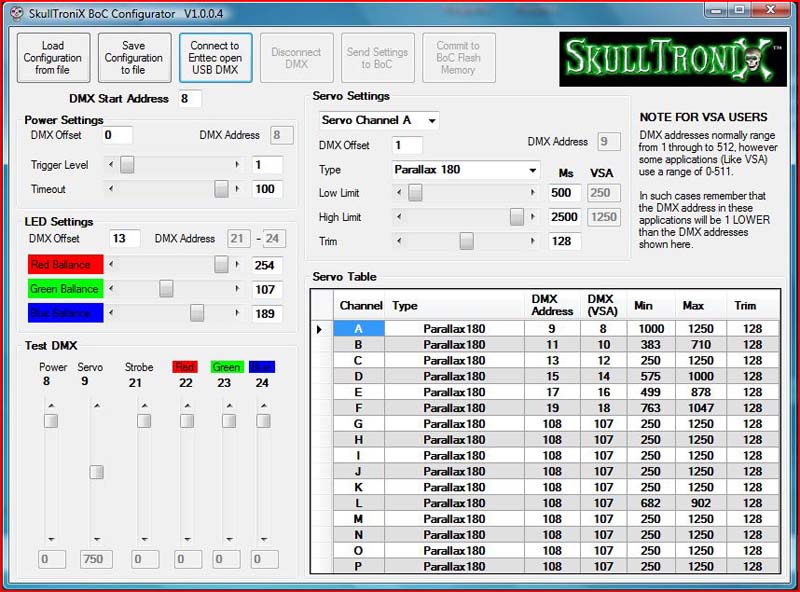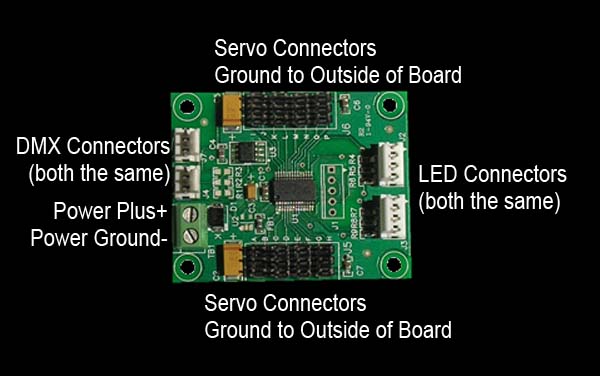

Note: Discontinued Product. Replaced with the SOC Controller. The Board of Chuckee (aka BOC) is a 16 channel servo controller for use on a DMX network. We designed the BOC after all the other servo control boards on the market fell short of our needs.
Here's a brief list of the BOC features:
- DMX compatibility: DMX is the standardized wiring system used in theaters and stages throughout the world. The cabling is simple.
You just run DMX cables from one device to another. You can even buy wireless DMX receivers/transmitters.
Devices get assigned a DMX base address (512 maximum). There are many types of DMX devices including lighting, strobes, fog/haze machines, video players,
sound players, relays, dimmers and much more. Because the BOC is DMX compatible you can control it with almost any of the hundreds of DMX control systems and software packages on the market. But we
designed the BOC for use with the VSA control software from Brookshire Software and only support it's use with VSA.
- 16 Servo Channels: Each servo can be configured with the following options:
- Servo Resolution: 8 or 16 bit. In 16 bit mode the servos mimic servos on a Parallax board.
This allows users upgrading from the Parallax board the ability to use the same animation routines. 8 bit mode allows using animation routines written for the mini-ssc board to be used.
16 bit servo mode uses 2 DMX channels per servo.
- Servo Direction: Clockwise or Counter Clockwise (only in 16 bit mode). Why? Well Futaba and Hitec, the major servo suppliers sell servos that are reverse of each others.
If you want to change from one brand to the other this becomes a handy feature. This is a feature found in more expensive digital servos but now available using inexpensive analog servos.
- Servo address: Set individually per servo. Servos can even share DMX addresses. The address is set as an offest from the base address.
- Servo End Points: You can easily configure the BOC to keep servos from traveling past whatever end points you want. This is a feature found in much
more expensive digital servos - in essence allowing you to use less expensive analog servos where you might normally have to use digital servos.
- Trim Adjustment: You finally get that complicated project built only to find out that one of the servos needs a minor adjustment and t is hard to reach. No problem.. whip out your BOC configuration program and adjust the servo plus or minus 10% in the BOC board.
- Servo Resolution: 8 or 16 bit. In 16 bit mode the servos mimic servos on a Parallax board.
This allows users upgrading from the Parallax board the ability to use the same animation routines. 8 bit mode allows using animation routines written for the mini-ssc board to be used.
16 bit servo mode uses 2 DMX channels per servo.
- Built-in servo saving circuitry: The BOC will automatically shut off the PWM signal to your servos after one minute of lost DMX signal. The timer
defaults to 1 minute but you can configure the setting.
The "power channel" is a DMX relay. The trigger level can be set using the BOC configuration program. Note: shutting off the PWM signal to some digital servos will not make them
shut down. This feature does work with all analog servos we have tested.
- Color LED driver: There are 2 connectors on the BOC board to plug in RGB LEDs. There are several configurable options for the LEDs:
- DMX Address: The LEDs use 4 DMX channels (both connectors are on the same DMX addresses):592
- Brightness/Strobe: Values from 0-127 make the LEDs strobe at the rate you set: Values from 128-255 set the overall brightness of the LEDs.
- Red: 0-255
- Green: 0-255
- Blue: 0-255
- Color Balance can be set for each of the colors (RGB) separately using the BOC Configuration program
- Brightness/Strobe: Values from 0-127 make the LEDs strobe at the rate you set: Values from 128-255 set the overall brightness of the LEDs.
This screen shot shows the BOC Configuration Screen. Note that the starting DMX address defaults to 8 (7 in VSA). You cannot use DMX addresses below 8 with the BOC, nor should any devices on your DMX chain use addresses below 8. Why? you ask... Because we send data to the first 8 addresses when we want to commit changes to permanent memory and if you use those addresses for other devices you might accidentally set the BOC into a mode that will make it forever unreachable.

For more information on the BOC please see the following documents:
- LED Specifications: Nichia part number NSTM515AS
- BOC Board specifications
- BOC Configuration Tool Docs
- BOC Cable Parts
- BOC Configuration Program

Frequently asked questions:- Q: May I order BOC parts (cables, power supplies, LEDs) from SkullTroniX?
A: Yes, but there is a minimum order of $50 and parts are NOT returnable. You will get better prices from Mouser or Digikey or other suppliers. It is a 5 volt, 4 amp wall wart. 4 amps is suitable for most projects but you need to determine your own power requirements. - Q: I'm trying to use the BOC board with "X" DMX controller (not VSA) and t doesn't work. What should I do?
A: We don't know. We've never used any DMX controller other than VSA. - Q: What is the warranty on the BOC board?
A: None. Since we have no control over how you will use or misuse the board there is no warranty. If you hook up the power backwards, fail to use static protection or any of a hundred other causes of damage we cannot eat the cost of the replacement. Each board is tested prior to shipment. - Q: What is the default configuration for the BOC?
A: See the BOC configuration screen shot above. It shows the default configuration as it ships. These are actually the default values for our Rev 4 DMX SkullTroniX. - Q: How do I use multiple BOC boards on the same DMX chain?
A: You need to set each BOC's base address far enough apart to not overlap. Example: A SkullTroniX DMX skull uses 6 16 bit servos. Therefore the servos eat up 12 DMX channels. There is one DMX channel for the power saver circuit, 4 DMX channels for the eye lights. That totals 17 DMX channels. If your first skull is at DMX base address 8 the next skull has to be at base address 25 (or higher). - Q: VSA only supports 128 DMX channels. What if I need more?
A: Take a look at our DMXorcist product. Combined with the "Masher" program you can get up to 512 channels.
- DMX Address: The LEDs use 4 DMX channels (both connectors are on the same DMX addresses):592
